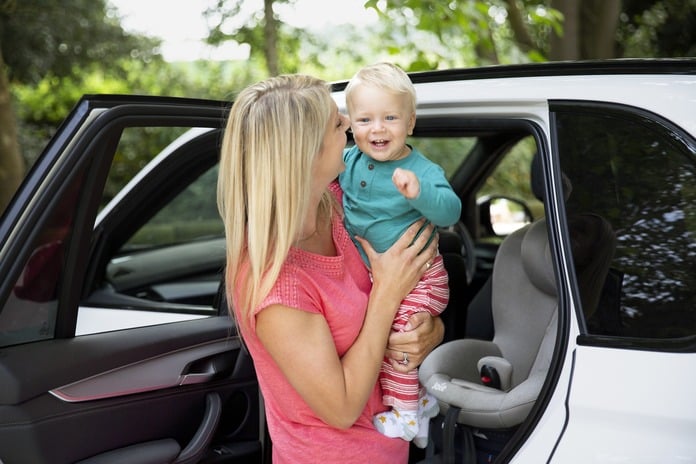From squirming newborns to noisy toddlers, most children find it a chore to sit still in the car. A good car seat will make your little one’s journey all the more comfortable, it’s also a legal requirement in the UK from newborn to around 12 years old. However, rules and regulations can be confusing, and that’s before you’ve even started browsing the market, which is hugely saturated with seats of all kinds. From the UK laws to the different styles, there’s a lot to bear in mind. Here we’ve rounded up the things to look out for when buying a car seat.
First and foremost
Generally speaking, your new car seat should meet the following requirements. Firstly, it should conform to the UN standard, ECE Regulation 44.04 (or R 44.03) or to the new i-size regulation, R129. For this, you’ll want to look for the ‘E’ mark label on the seat. Secondly, the seat should be suitable for your child’s weight and size, whatever age they are. Where possible, you might want to take your child and your car with you when buying, to test the product out properly. Finally, the seat must be correctly fitted according to the manufacturer’s instructions.

i-Size
You no doubt want the very best for your child and that means the safest seats. Many manufacturers will subject their seats to vigorous testing regimes in order to establish just how safe they really are, and to ensure they comply with UK safety standards. Introduced as a new legislation in 2013, i-Size seats aim to offer improved protection for younger children. These seats go by height instead of weight. While some baby car seats can be installed using the car’s adult seat belt, a true i-Size car seat, such as the Joie i-Spin 360, will only use Isofix connectors. i-Size car seats will fit all i-Size-certified cars and almost all cars with Isofix.
It’s mandatory for a baby to be rear-facing in an i-Size seat until he or she is 15 months old. The Joie i-Spin 360 fits rearwards but also smoothly pivots to face forwards and every way in between, so that getting them carefully in and out couldn’t be easier. It also uses protective safety panels which auto-engage when the harness is tightened to provide an extra level of safety. The seat has 19 adjustable positions which easily adjust for the best fit. This is a fantastic feature; ensuring that the seat is suitable for the height of your child is one of the most important considerations before buying. It’s also worth checking with the car manufacturer to see in which position you can use an i-Size car seat in your vehicle. Only EU-approved height-based child car seats can be used in the UK. These have a label showing a capital ‘E’ in a circle and ‘R129’.
Weight-based seats
The seat your child can use depends on their weight. All car seats fit into one of two groups according to the weight of the child they’re designed to protect. These groups are defined by United Nations safety regulations and cover children from birth all the way up to 12 years old or 135cm. Moving babies and younger children to the next group before they reach the maximum weight or height for their seat could lead to more severe injuries in a crash. It’s also against the law to put your child in a seat that’s inappropriate. Only EU-approved weight-based child car seats can be used in the UK. These have a label showing a capital ‘E’ in a circle and ‘ECE R44’.
Fitting
UK car seats are usually classified by weight (and occasionally by height through the EU i-Size safety standard). Checking your little one’s weight and height is curcial , as you’ll need this information before you begin your search. It’s important that you only use a child car seat if your car’s seat belt has a diagonal strap, unless the seat is either specifically designed for use with a lap seat belt, or is fitted using ISOFIX anchor points. Crucially, you must also deactivate any front airbags before fitting a rear-facing baby seat in the front seat, and do not fit a child car seat in side-facing seats. Joie’s Fit Guide is a really useful and easy-to-use tool when it comes to checking vehicle compatibility. All you need to know is the weight and height of your little one, as well as the make and model of the car(s) you want to check. It is also the only guide on the market that offers the option to compare three different vehicles all at once.
Plus Test Certified
Whether or not a car seat is Plus Test certified is something you may want to consider. All child car seats sold in the European and Scandinavian market must be approved – and the Sweedish Plus test is the best approval a car seat can get. The requirements of the test are very strict – a forward facing car seat would not be able to pass – this is because a rear facing seat protects necks up to 80% more than forward facing seats. A Plus Test approval means that the car seat effectively prevents any severe or life threatening injuries in a collision. Given the severity of the test, only a select number of car seats have even passed it. Joie’s spin-safe is their toughest tested car seat and is Plus Test certified. It spins side to side and packs in all round safety and simplicity.
For more information about Joie or the Joie spin-safe car seat, and to see what other products are available, visit joiebaby.com
